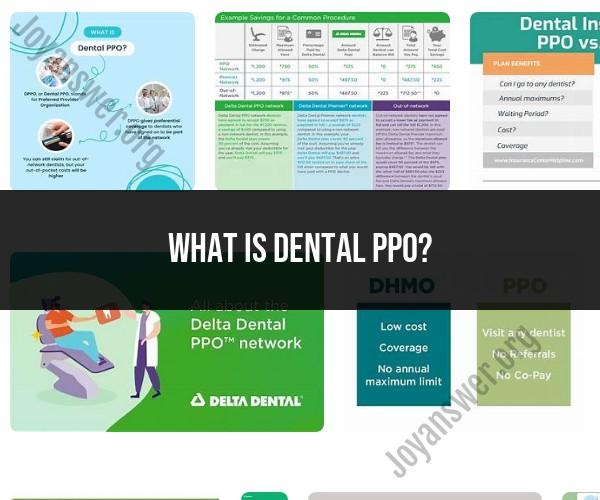What is dental PPO?
A Dental Preferred Provider Organization (Dental PPO) is a type of dental insurance plan that offers a network of dentists and dental specialists to provide dental care services to plan members. Dental PPO plans are a common form of dental insurance in the United States and are designed to help individuals and families cover the costs of dental procedures and treatments.
Here are the key characteristics and features of a Dental PPO plan:
Network of Dentists: Dental PPO plans typically have a network of participating dentists and dental providers. These dentists have agreed to provide services to plan members at negotiated rates, which are often lower than what they would charge individuals without insurance. Members can choose to receive care from any dentist, but they generally receive higher benefits when they visit in-network providers.
Out-of-Network Coverage: While Dental PPO plans encourage members to use in-network dentists to maximize cost savings, they also offer coverage for out-of-network dental services. However, out-of-network care may result in higher out-of-pocket costs for plan members.
Cost Sharing: Dental PPO plans often involve cost-sharing arrangements, including deductibles, copayments, and coinsurance. Plan members typically pay a portion of the cost for covered services, and the insurance plan pays the remaining portion.
Preventive Care: Dental PPO plans commonly cover preventive dental care at a higher rate or even fully. This includes services like regular check-ups, cleanings, and X-rays, which are essential for maintaining good oral health.
Basic and Major Services: The plans also cover a range of basic and major dental services, such as fillings, root canals, extractions, crowns, bridges, and sometimes orthodontic care. The coverage levels for these services can vary, with basic services typically covered at a higher rate than major services.
Annual Maximum Benefit: Dental PPO plans often have an annual maximum benefit, which is the maximum amount the plan will pay for dental care within a calendar year. Any costs incurred beyond this limit are the responsibility of the plan member.
No Referrals Required: Unlike some other types of health insurance plans, Dental PPO plans do not require referrals from a primary care dentist to see a specialist. Members can typically visit specialists directly.
Freedom of Choice: One of the advantages of Dental PPO plans is that they offer flexibility. Members have the freedom to choose their dentist, even if they are out-of-network, and can receive services without referrals or gatekeepers.
Waiting Periods: Some Dental PPO plans may have waiting periods for certain types of services, particularly major procedures or orthodontic care. This means that coverage for these services may not be immediate after enrolling in the plan.
It's essential to review the specifics of your Dental PPO plan, including the network of providers, covered services, costs, and limitations, before making dental care decisions. Also, consider factors such as premiums, deductibles, and annual maximums when evaluating the overall value of the plan. Dental insurance can be an important tool in managing the costs of dental care and maintaining oral health.
Dental PPO: What You Need to Know About Preferred Provider Organizations
A dental PPO, or preferred provider organization, is a type of dental insurance plan that contracts with a network of dentists to provide discounted rates for services. This means that you will pay less for dental services if you visit a dentist in your plan's network.
Understanding Dental PPO Plans and Their Benefits
Dental PPO plans typically offer a variety of benefits, including:
- Preventive care: Preventive care services, such as cleanings, exams, and X-rays, are typically covered 100% by dental PPO plans.
- Basic services: Basic services, such as fillings, root canals, and extractions, are typically covered at a percentage of the cost.
- Major services: Major services, such as crowns and bridges, are typically covered at a lower percentage of the cost.
Dental PPO plans also typically have a deductible, which is the amount of money you have to pay out of pocket before your insurance starts to pay. The deductible is usually reset at the beginning of each calendar year.
Exploring the Basics of Dental PPO Insurance
Here are some of the basics of dental PPO insurance:
- Network of dentists: Dental PPO plans have a network of dentists who have agreed to provide discounted rates for services. You can usually find a list of dentists in your plan's network on your insurance company's website.
- Copayment: A copayment is a fixed amount of money that you pay for covered services. For example, you may have a $25 copayment for a cleaning.
- Coinsurance: Coinsurance is a percentage of the cost of a covered service that you pay after you have met your deductible. For example, you may have 20% coinsurance for basic services.
If you are considering purchasing a dental PPO plan, be sure to compare different plans to find one that meets your needs and budget. You should also consider the following factors when choosing a dental PPO plan:
- Network of dentists: Make sure that your plan's network includes dentists that you are comfortable seeing.
- Copayments and coinsurance: Compare the copayments and coinsurance for different plans to find one that is affordable for you.
- Benefits: Make sure that the plan you choose covers the services that you need.
Dental PPO plans can be a good option for people who want the flexibility to choose their own dentist and the financial protection of dental insurance.













